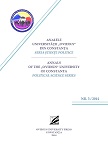Political Representation of the Romanian Women in the National and European Parliament. How Big Is the Gender Gap?
Political Representation of the Romanian Women in the National and European Parliament. How Big Is the Gender Gap?
Author(s): Mihaela IvănescuSubject(s): Politics / Political Sciences
Published by: Ovidius University Press
Keywords: gender; political rights; representation; national elections; European elections
Summary/Abstract: The last decades have been marked by the intensification of women participation in political activities worldwide, closely connected to the efforts of many minorities to assert their own identity. The main goal of this paper is to analyze the evolution of the Romanian women political representation, both in the national and the European legislative institutions. We have chosen this type of comparative approach in order to identify the tendencies of women representation and to observe the similarities or the differences between the political parties’ approach regarding their women candidates in the national and European elections. The first part of this paper consists in a short analysis of some aspects of the Romanian women’s struggle for the acquirement of civil and political rights, more exactly of the right to vote (and participate as candidates in the elections) and to identify some distinct features of the feminist movement in Romania regarding the efforts to obtain electoral rights. The second part of the paper is based on a comparative analysis of the women representation in the Romanian Parliament after 1990 and in the European Parliament after Romania’s accession to the European Union, in 2007. We argue that, in spite of the fact that the percentage of the deputy and senator mandates for women has practically doubled in Romania at the parliamentary elections in 2012, compared to the 1990-1992 legislature, the level of representation for women in the national Parliament still remains extremely low compared to the situation of other European countries. The same tendency can be observed regarding the mandates for the European Parliament, although in this case the results are close to the European average.
Journal: Annals of the Ovidius University of Constanta - Political Science Series
- Issue Year: 3/2014
- Issue No: 1
- Page Range: 93-108
- Page Count: 16
- Language: English

